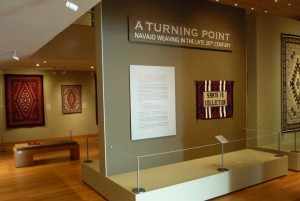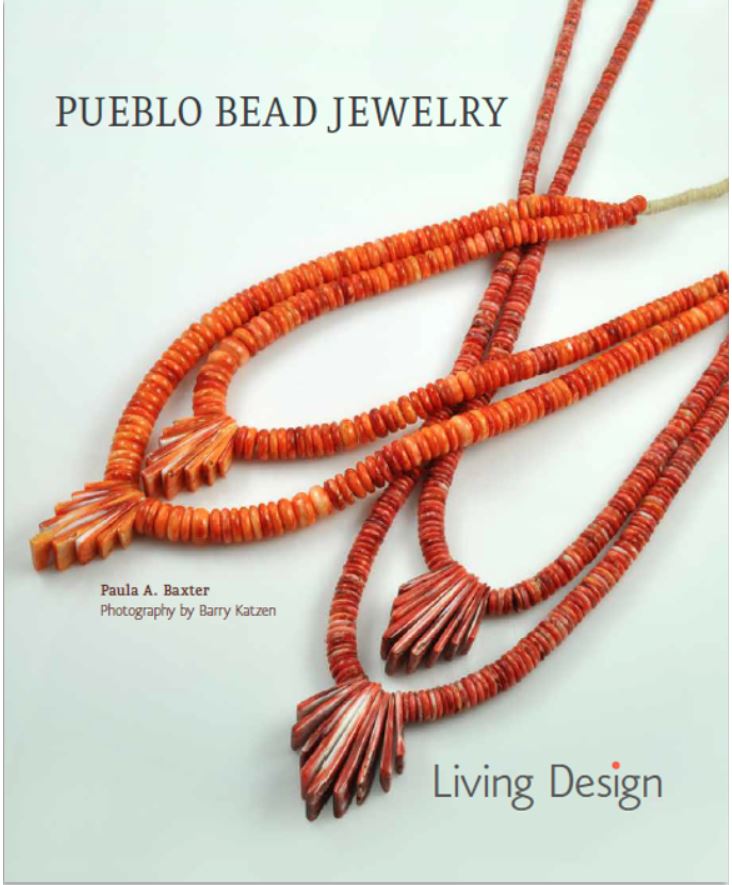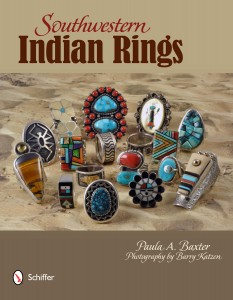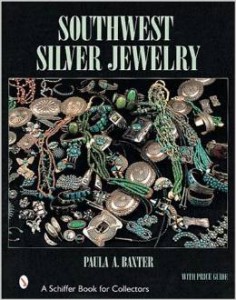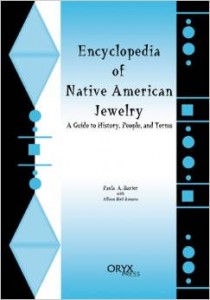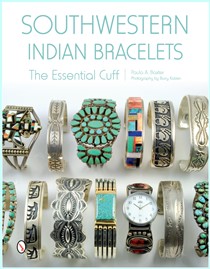We still remember that tourist from Europe we ran into in Scottsdale a year ago who wanted to know where “all the Indians” lived and worked! Someone we’ve known for a while, who resides in Prescott, is a Native equally at home in his traditional society and in the wider world of art, antiques, and collectibles. We’re referring to talented Navajo silversmith and jeweler Ernie Lister, who runs a small antiques shop off the lobby of the Montezuma Hotel, a historic old-time lodging place. His Hotel Trading Company features tantalizing Native and non-Native vintage works, from concha belts to pottery to estate jewelry and adornment.
While he minds the store, Ernie also runs his work bench, from which spot he fashions delectable silver and stone creations. He’s a top-of-the-line artist, able to switch back and forth from old style to avant-garde forms, whose works are sought by collectors at home and abroad (he has a following in Japan). One of his pieces appears in our forthcoming book Southwestern Indian Rings (Schiffer, November 2011). Lister is a refreshing example of a Native art expert in Indian country, and a change from the non-Native dealers who dominate the vintage Indian arts market.
The souvenir nature of low-end Indian arts, spurious vendors holding travelling Indian arts shows with questionable goods, and bogus sales discounts of 50% or more off already jacked-up prices, have all contributed an aura of sleaze to the marketplace. Sadly, many tourists consider the awful things they see in tourist stores as representative of the genuine article. This problem is so endemic, even the U.S. government has gotten into the protectionism business. The Indian Arts and Crafts Act of 1990, P.L. 101-644, co-sponsored by Congressman Ben Nighthorse Campbell, a Southern Cheyenne jeweler by profession, put in place a truth-in-advertising law that prohibits misrepresentation in the marketing of Indian arts. Over the past decade, New Mexico and Arizona have passed state laws related to this federal act, yet the verdict is out on how successful and consistent enforcement will be. Until then, be careful what you buy.
Watch a video about buying authentic Indian Arts and Crafts.
Download a brochure (PDF) about “How to Buy Genuine American Indian Arts and Crafts.”
Want somewhere different to go on Memorial Day? Those lucky enough to be in the Four Corners region should consider attending the 11th annual Indian Arts and Culture Festival in Mesa Verde Country in southwestern Colorado, May 27 – June 5. Much of the Indian Arts show is held at Mesa Verde National Park. This is by all accounts a small show but one that leaves a pleasant feeling. We tried to attend this exhibition a few years ago, only to be sidelined by either salmonella or a really bad stomach bug. Whatever it was, it kept us hotel-bound and far from able to traverse the Park’s long and winding two-lane ascent road. If anyone attends this show this year, we’d love to hear impressions. One event that is regularly heralded is a Navajo rug seminar and auction run by experts in the field. Make Cortez the base for your visit.
Our eyes were caught by a small article in the June issue of Cowboys and Indians. Written by Sandy Yazzie Tsosie of Kayenta, clearly a local resident, it is a delightful survey of what it would be like to camp overnight on Hunts Mesa at the Monument Valley Tribal Park. The experience requires four-wheel-drive and a permit, but sounds like something that would make a great memory. The vast sky overhead changes so much over a twenty-four period, that it’s like watching a pageant. Get information at www.navajonationparks.org/htm/monumentvalley.htm
You will find purists who turn up their noses as jewelry made from treated turquoise. Natural turquoise is preferred by all, but its availability is limited nowadays. As a collector, I have discovered that my Southwestern souvenirs, rare or not, often fare poorly in East Coast pollution. Over the years, cracks and chips develop even in the best stones. Some of the techniques used on treated turquoise give contemporary stones a fighting chance against air-borne contamination. Learning the definitions for stabilized, enhanced, oiled or waxed, fracture sealed, reconstituted, and dyed turquoise makes the collector a better consumer. Buy from a vendor or seller who is ready to disclose what kind of turquoise is in their product.
One of the highlights of attending the Heard Museum Guild Indian Fair and Market, which seemed to be bigger and better than in previous years, was the museum’s exhibition, A Turning Point: Navajo Weaving in the Late 20th Century. Shows like these help collectors and interested people to pinpoint artistic trends and development. For a craft rooted in the nineteenth century, Navajo weaving has come a long way. Discoveries include:
- use of popular culture references, such as brands
- titles for certain compositions
- inclusion of rugs within other rugs to create a “framing” concept
- weavers’ pathways as significant elements
The Storm Pattern rugs were the most vivid standouts in this great exhibition.
We always enjoy receiving the newsletter from River Trading Post, with galleries in Scottsdale, AZ, Santa Fe, NM, and Dundee, IL. We enjoy visiting River Trading during the annual Art Walk held before the Heard Museum Guild Indian Fair and Market. They represent a fine lineup of artists, including multi-generational talent. A recent newsletter announced findings from a survey of collectors. According to those they surveyed, collectors prefer purchasing both older and contemporary Native-made arts. Pottery and jewelry were the leading choices for acquisition, and they particularly look to magazines American Indian Art and Native Peoples for information.
Hmm… Are you subscribing to their newsletter? (Go to their website to sign up.)
One of the greatest treasures of the Tucson region lies off the highway at 4410 S. Mission Road. We first heard about Turquoise Skies through an older travel guide. Being up-to-date, we did an online search and found a cheerful little website for a truly wonderful place.
Turquoise Skies is run by two local men, Robert Seymour and Marshall Kidder, who have an eye for the quality in Native-made arts. Turquoise Skies is a small shop, but inside are some of the most amazing Tohono O’odham baskets we’ve ever seen. The owners have been in business for a long time and know many artists well. This knowledge has brewed an intriguing selection of jewelry, pottery, weavings, basketry, stone carving, and fine arts. On the day we stopped, they disclosed how Tucson’s venues for Indian arts have dwindled from more than forty to just a handful. This is one of the best, with very good prices. Visit them online at http://turquoiseskies.com
The Tohono O’odham reservation abuts the city limits of Tucson. These Sonoran Desert dwellers, who were known as the Papago Indians in less enlightened times, are particularly known for their basket and object weaving. They are also masters of an important design motif: the man in the maze.
Dating to the pre-contact era, this design symbolizes a keen understanding of man’s physical and metaphysical existence. Today, the man in the maze motif appears on many Southwestern Native arts, including jewelry.
